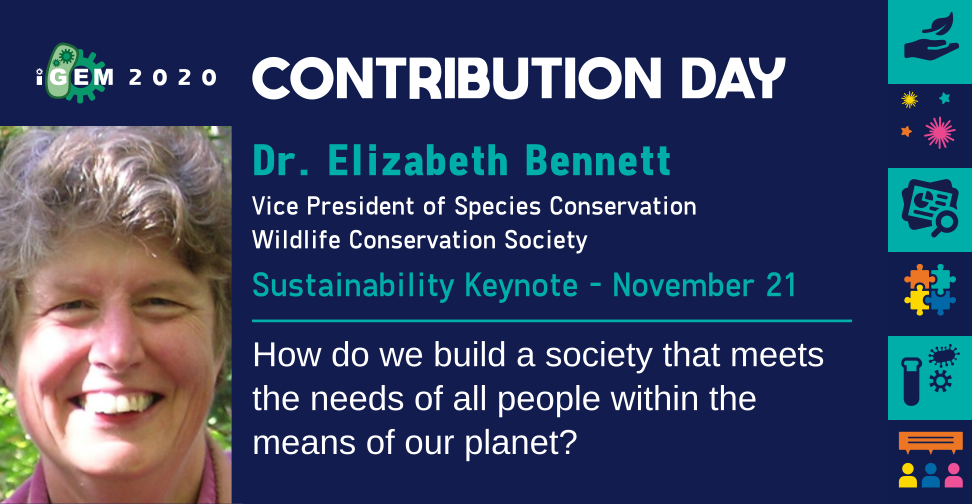Conservation Conversations: Reflections on the 2021 IUCN Global Youth Summit
by Tessa Alexanian, Emilia Hannibal,
and the After iGEM Fellows for the IUCN Global Youth Summit
At iGEM, we believe synthetic biology can contribute to the Sustainable Development Goals, helping us to build a society that meets the needs of all people within the means of the planet. In the words of Dr. Elizabeth Bennett during her Sustainability Keynote at the 2020 Giant Jamboree:
“Synthetic biology gives us a set of tools that we didn’t have before to potentially inform the way we do conservation”
The poster from Dr. Elizabeth Bennett’s keynote talk at the 2020 Giant Jamboree
In the same talk, Dr. Bennett shared how synthetic biology wasn’t really on her radar until attending a meeting organized by the IUCN (the International Union for the Conservation of Nature) in 2015, which brought together the synthetic biology and conservation biology communities; the meeting “opened her eyes to a whole world out there, which has some clear risks, but also some potentially fabulous tools that she was unaware of”.
You can imagine we were excited to learn about the 2021 IUCN Global Youth Summit, a 10-day virtual event that brought together young leaders, conservation organizations, and many others, to add momentum to the growing youth movements for nature and climate. We think our community should be a part of these movements, and so 14 After iGEM Fellows were selected to participate in the open, global summit and enjoy additional connections with fellow synthetic biologists exploring conservation issues. This post will share their reflections and experiences.
After iGEM Fellows for the IUCN Global Youth Summit
Our amazing group of fellows was selected from among 93 applications. The fellows hail from the countries and regions China, France, Pakistan, Hong Kong, India, Mexico, Uganda, USA, and Zimbabwe, and have all participated in iGEM in the past, including current and past members of our Ambassador Program and After iGEM networks.
After iGEM 2021 IUCN Conference Fellows
Introducing our amazing fellows, and their various involvements in iGEM and After iGEM:
Erikan Baluku (Uganda): Team Makerere University 2018, After iGEM Ambassador & Open Science & Accessibility Steering Group 2021
Sayantani Biswas (India): Team IISER Berhampur 2020
Onkar Date (India): Team MITADTBIO Pune 2019, EPIC Regional Head for APAC 2021
Jorge Hernández (Mexico): Team FCB-UANL 2020, UANL 2019, CIDEB-UANL_Mexico 2014
Megan Hong (USA): Team Lambert GA 2017-2019
Erin Kim (USA): Team MIT 2020, After iGEM Ambassador 2021
Sabrina Lerskiatiphanich (Hong Kong): Team Hong Kong HKU 2020-2021
Frank Liu (USA): Team GreatBay_SZ 2019, After iGEM Academia & Research Steering Group 2021
Qitong Luan (USA): Team Gaston Day School 2018, After iGEM Ambassador 2021
Stephen Mukuze (Zimbabwe): Team Zimbabwe 2020, After iGEM Open Science & Accessibility Steering Group 2021
Michael Heyuan Ni (China): Team Beijing 4ELEVEN 2020, BHSF ND 2019
Marsad Siddique (France / Pakistan): Team LACAS BioBots 2018-2019, After iGEM Education Steering Group 2021
Shruti Sridhar (India): Team BITSPilani-Goa_India 2020, After iGEM Education Steering Group 2021
Melody Wu (USA): Team MIT 2019, Alverno_CA 2016, After iGEM Ambassador 2020
Reflections on Synthetic Biology and Conservation
In her keynote, Elizabeth Bennett shared that, “One of the greatest challenges is that governments around the world, as well as a lot of the conservation community, really is still unaware of synthetic biology and what it can do and how it can potentially provide useful tools.” This reflection was shared by our fellows.
“I don’t think there are enough interactions or opportunities to encourage a better understanding of each other’s perspectives even though we are ultimately striving towards the same goals of sustainability.” - Erin Kim
“Even for projects that have the potential to contribute to a conservation cause, the scientists seem to not especially have an ear on the needs of the conservationists.” - Michael Ni
“All the fellows I believe would agree that the gap in the communication is because we are not talking enough about the solutions synthetic biology can provide and is providing.” - Sayantani Biswas
Some fellows felt like synthetic biologists need to do more to address the reservations people have about the field.
“I used to think synthetic biology and biotechnology were taken very positively by the overwhelming majority of people - however I realised after this summit that that is not entirely true. [...] It’s our responsibility as members of this community to ensure that we create safe-spaces for discussion and debate and promote a better understanding of the discipline amongst the general public and conservationists.” - Marsad Siddique
“I learnt that people have many misconceptions about gene drives, thinking gene drives can act as bioweapons and are not reversible.” - Erikan Baluku
Other fellows were pleasantly surprised to be met with curiosity rather than skepticism when they found themselves in conversations about synthetic biology.
“I first had this perception of ecologists as synthetic biology “haters,” you know, with this “PETA” or “Friends of the Earth” perspective. I was mentally predisposed to have these heated arguments with extremists, but I didn’t find a single person like this during the whole extent of the conferences and forums. We all had in common the goal of conservation [...] we were all trying to solve the same issue.” - Jorge Luis Hernández Ayala
“I was first introduced to this common misconception people had: synthetic biology can harm the environment in various ways. However, talking to people at the summit, I find that this misconception is, in fact, somewhat a misconception that synthetic biologists had about the crowd. Many are actually interested in seeing what synthetic biology can potentially contribute to conservation actions.” - Michael Ni
“I talked to a young woman who was interested in natural solutions to industrial chemical products. She was very passionate about her work. [...] I asked if she had considered synthetic biology as a solution, and apparently she was against it. I shared some of my work with indigo and another synbio-produced dye, which altered her view slightly, but more importantly, gave an example that she could relate to. I found this conversation showed the diversity of approaches towards conservation.” - Frank Liu
The fellows also noted some unexpected commonalities between the synthetic biology and conservation communities. Both are highly interdisciplinary, and thus face the challenge of trying to communicate with diverse and sometimes disconnected groups.
“Similar to synthetic biology, conservation requires diverse talents - science communicators, policy makers, ecologists, and other specialised scientists - to come together and collaborate [...] The two fields are not as disparate as they may initially seem, and there is immense room for both fields to grow their audience through exploring the other’s field.” - Sabrina Lerskiatiphanich
“I think the right word to describe both communities is intersectional and the intersectionality of these identities is often ignored because of how they might be perceived by both given the ways in which conservation and synthetic biology have respectively been communicated to the public.” - Melody Wu
“Due to the lack of effective communication between synthetic biology and conservation, there is a loss of potential growth in both fields. I attended a session that focused on communication of science and technology to different audiences, and the panelists emphasized the need for functional writing in policy in order to see results.” - Megan Hong
Education and youth engagement were major themes of both the summit and of the fellows’ reflections:
“There was discussion about the value of youth: how youth should be understood as an inherent asset, rather than a promotional diversity factor. This opened up a conversation about how many youth are not waiting for policy to be implemented. Rather, they are actively searching for solutions they can apply and scale-up on their own as part of their voice in conservation efforts.” - Sabrina Lerskiatiphanich
“One of the most valuable sessions I attended was on Transformative Education by the Global Youth Biodiversity Network. Education plays a crucial role in our transition towards sustainable and just societies. The emphasis on integrating biodiversity in curricula of all levels was fascinating.” - Shruti Sridhar
“One of my key learnings from the Summit was the need to dive into the aspects of conservation from a younger age. As you learn about new topics, and techniques and methods as part of your education, you get a great opportunity to learn about the impacts, implications and applications of the same. [...] The iGEM Community also contains many highschoolers and undergrads, for whom this is the ideal time to also be thinking about conservation and sustainability. Strike while the iron is hot! Engage and interact! Use those scientific minds to think about how you can apply what you learn into this field as well!” - Onkar Date
The fellows emphasized a need for further cooperation and collaboration between the synthetic biology and conservation as this global youth movement increases its momentum:
“I noticed that there was not a single event dedicated to synthetic biology and conservation in the whole agenda. [...] Perhaps we should participate as iGEM representatives in these seminars, to share the opportunities that synthetic biology offers for conservation while considering all of the different perspectives that we learned during this event.” - Jorge Luis Hernández Ayala
“Synthetic biologists must collaborate with conservationists when designing their solutions to address biosafety issues with regards to ecosystems.” - Stephen Mukuze
“At the end of the day, humans are going to have to reverse the damage done to the Earth by other humans. [...] We need to approach these fields with this mindset rather than feeling that our efforts are in vain in the grand scheme of things [...] By bridging the gaps between these perspectives and having important conversations about these common areas, we can achieve our collective goal of making the world a better place.” - Megan Hong
We are excited about the contributions made by our After iGEM fellows at the 2021 IUCN Global Youth Summit, and look forward to seeing how their future paths evolve. If you want to get involved yourself, the IUCN Global Youth Summit is currently accepting feedback on its draft outcomes statement, which will be presented at the IUCN World Conservation Congress in September 2021, and you can follow After iGEM on Twitter or LinkedIn to hear about future conference fellowship opportunities.










